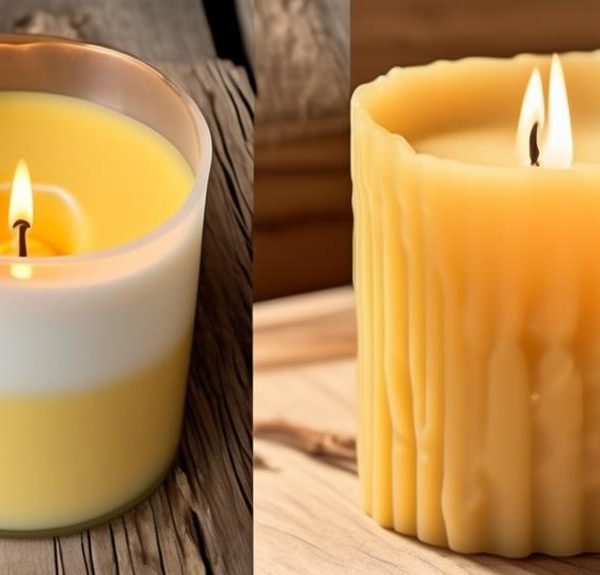Stumble upon the uncanny intersection of entomology and tennis as we explore the peculiar possibility of bees getting stuck to tennis balls.

Do Bees Get Stuck to Tennis Balls?
In the quiet hum of a sunlit meadow, you wouldn't typically think of the buzzing chaos at the Wimbledon finals.
Yet, there's an unusual intersection between these two worlds: the curious question of whether bees can get stuck to tennis balls.
You're probably wondering how these tiny creatures and fuzzy green spheres could possibly relate, right? Well, it's a peculiar query that merges the realm of entomology with the world of sports.
Stick around, and you'll find out just how this odd scenario could unfold.
Key Takeaways
- Bees have tiny, branched hairs that can become stuck to sticky surfaces like tennis balls.
- The saliva of a dog can cause the bee's hairs to stick to the ball.
- Tennis balls have a fibrous felt exterior and an inner rubber layer that can potentially trap bees.
- Bees are unlikely to get stuck on tennis balls due to their legs' design for gripping rough surfaces and the looser fibers of the tennis ball compared to flower petals or tree bark.
Understanding Bee Anatomy
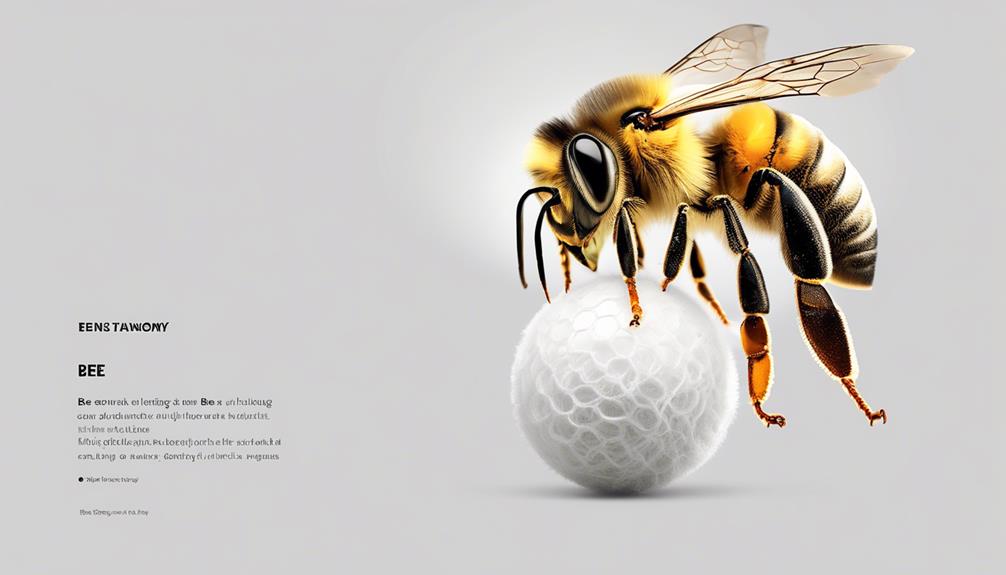
To fully comprehend why bees might get stuck to tennis balls, you've got to dive into the intricate details of bee anatomy. Bees are covered in tiny, branched hairs, designed to trap pollen. This allows bees to transport the pollen back to their hives. However, these hairs can also become a hindrance when they come into contact with sticky surfaces, such as a tennis ball that's been in a dog's mouth.
The saliva of a dog contains a certain level of viscosity that can cause the bee's hairs to stick. As the bee attempts to free itself, it only further entangles its hairs into the ball's fuzzy surface. The bee's anatomy, specifically their legs, lack the strength and flexibility to pull free from such a sticky situation.
Moreover, a bee's wings, despite their delicate appearance, are quite resilient. However, they aren't designed to deal with the type of resistance that a sticky surface presents. The wings can easily become trapped in the saliva-soaked fuzz, rendering them useless for flight.
Thus, understanding the bee's anatomy unlocks the mystery of their sticky dilemma with tennis balls.
The Texture of Tennis Balls
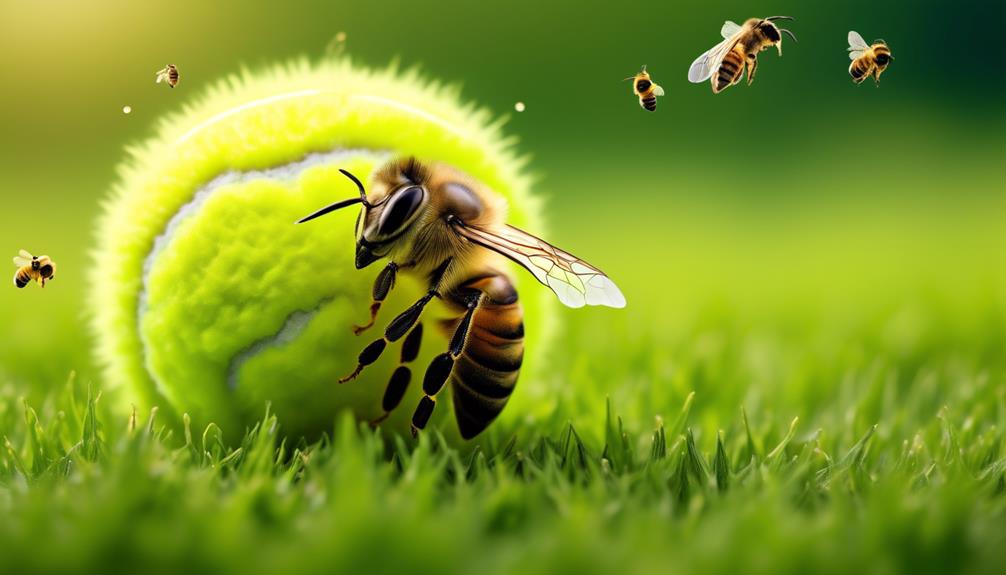
While you may not give it a second thought, the texture of tennis balls plays a crucial role in our bee conundrum. Let's delve into it.
The exterior of a tennis ball isn't smooth. It's covered in a fibrous felt, made of a wool and nylon blend. This felt, dyed optic yellow for visibility, is rough and fuzzy.
Why does it matter? This rough texture is key for tennis playability, offering the necessary friction for spin and bounce. But it also has implications for our bee question. The fibrous surface could potentially trap tiny bee legs, if the leg structure and texture interaction were just right.
Additionally, tennis balls have an inner rubber layer. This layer exudes a certain level of stickiness, which could further contribute to a bee getting stuck. However, this sticky substance is usually concealed by the outer felt layer and would only be exposed if the ball is damaged.
Interaction Between Bees and Tennis Balls
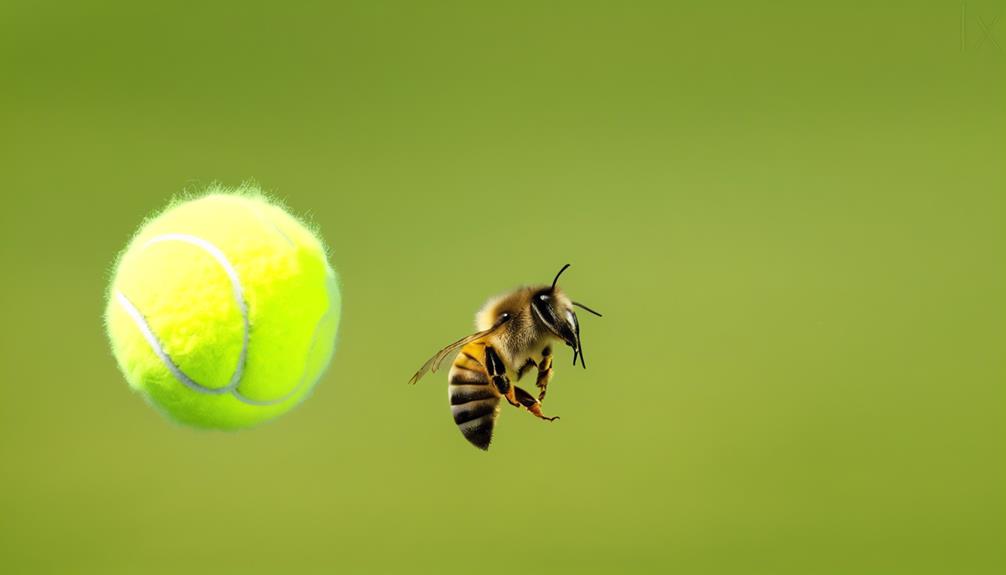
Having understood the unique structure of tennis balls, let's now consider how bees interact with them. Bees, being insects, exhibit a certain level of curiosity and exploratory behavior. When a brightly colored tennis ball enters their environment, they're likely to investigate.
However, bees' legs are designed for gripping onto rough surfaces, like the bark of trees or the petals of flowers. The fuzzy texture of a tennis ball, though similar in roughness, doesn't provide the same kind of grip for a bee. The fibers of a tennis ball are much looser compared to the tight weave of a flower petal or the intricate ridges of tree bark.
Also, remember that bees are covered in a thin layer of hair. This hair has a static charge that helps them collect pollen. However, the synthetic materials in a tennis ball don't contain the kind of pollen that bees are attracted to. Thus, while a bee might land on a tennis ball out of curiosity, it's unlikely to stick around or get stuck.
Scientific Studies on Insect Adherence

Delving into the realm of scientific studies, you'll find that researchers have conducted extensive experiments to understand how insects adhere to various surfaces. It's a world where the tiny feet of insects are under the microscope, scrutinized for the secrets they hold.
The primary mechanism of adherence in insects, you'll find, is often traced to two main structures: adhesive pads and claws. These structures, present in varying degrees across different insect species, help them stick and move across surfaces. You'll see that studies have demonstrated insects' remarkable ability to adhere to both smooth and rough surfaces, thanks to these specialized body parts.
You'll come across fascinating studies, like that of a 2017 research conducted by the University of Cambridge, that discovered some insects can adjust the stickiness of their feet depending on the surface. Moreover, you'll see how researchers have explored the role of surface texture and insect weight in adherence.
On a whole, the scientific research into insect adherence is extensive and ongoing. It contributes not only to our understanding of insects' incredible adaptability, but also provides insights for developing advanced adhesive technologies.
Implications for Tennis Players
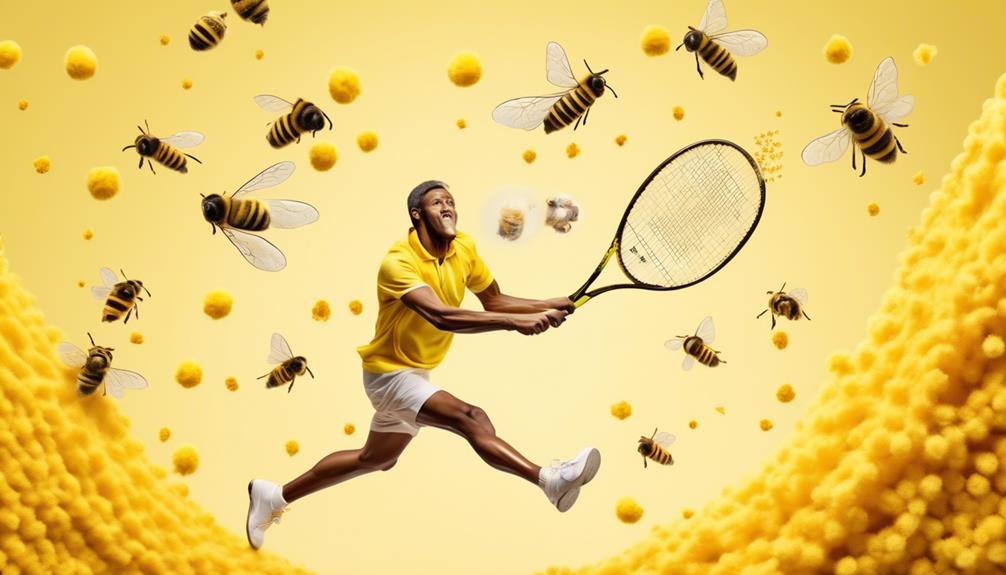
As a tennis player, you may wonder how the potential for bees to stick to your tennis ball could affect your game. Bees are attracted to the bright yellow color of tennis balls, mistaking them for flowers. If a bee were to adhere to the ball, it could impact not only the trajectory of the ball but also the weight, potentially affecting your shot's accuracy and power.
From an analytical perspective, the bee's weight, although minimal, might cause an imbalance. This could alter the ball's spin, speed, or bounce, potentially ruining a perfect serve or return. Moreover, the bee's irregular shape might create aerodynamic inconsistencies, affecting the ball's flight path.
Additionally, there's a safety concern. Bees don't intentionally sting, but in self-defense or if crushed. Hence, hitting a bee-attached ball might provoke a sting, causing pain or allergic reactions.
Therefore, it's crucial to monitor your tennis balls during play, especially in areas with high bee populations or during their active seasons. If a bee lands on your ball, it's recommended to let it fly away naturally or carefully remove it without causing harm. This way, you can ensure both your safety and the integrity of your game.
Frequently Asked Questions
What Is the Average Lifespan of a Bee?"
You're curious about the average lifespan of a bee, aren't you? It's quite fascinating, because a bee's lifespan varies depending on its role.
Worker bees typically live for 5-6 weeks in the summer, while drones live around 8 weeks. Queen bees, however, can live up to 5 years!
The environment and the bee's duties significantly impact its longevity. So you see, there's more to a bee's life than you might've thought.
How Are Tennis Balls Manufactured?"
You're probably curious about how tennis balls are made. Well, it starts with a rubber core, which is heated and pressurized. This process is called vulcanization.
The core is then coated in a felt-like material, usually a nylon or wool blend. This gives the ball its distinctive fuzziness, which affects how it bounces and spins.
It's a complex process, but it's absolutely necessary to ensure every tennis ball performs consistently.
What Kind of Flowers Do Bees Prefer?"
You're asking about the preferred flowers of bees. Well, bees aren't picky, they're attracted to a wide variety of flowers. However, they do have favorites.
They're particularly drawn to flowers that have a strong fragrance, bright colors, and provide a good nectar source. Some of their top choices include lavender, sunflowers, and rosemary.
Bees play a crucial role in pollination, so choosing a variety of these plants can help support their population.
Are There Any Health Risks Associated With Bees for Tennis Players?"
You're unlikely to face any health risks from bees as a tennis player unless you're allergic to bee stings. Bees typically don't pose a threat unless provoked. If you don't disturb them, they won't disturb you.
However, if you notice a lot of bees around your tennis court, it may be wise to have the area inspected and possibly treated by a professional pest control service.
Can the Color of the Tennis Ball Attract or Repel Bees?"
Yes, color can impact a bee's attraction or repulsion to a tennis ball.
Bees have excellent color vision and are particularly drawn towards bright colors such as yellow, which is the common color for tennis balls.
They're less attracted to darker colors.
So, if you're playing tennis, you might notice bees buzzing around yellow tennis balls more often.
However, a bee's color preference can vary among species.
Conclusion
So, do bees get stuck to tennis balls? The evidence suggests not.
Despite the fuzzy texture of tennis balls, a bee's anatomy, specifically their legs, allow them to navigate such surfaces without getting stuck.
Science backs this up, showing minimal insect adherence to these kinds of materials.
As a tennis player, you can serve with confidence; it's highly unlikely you'll be swatting away stuck bees from your game gear.


